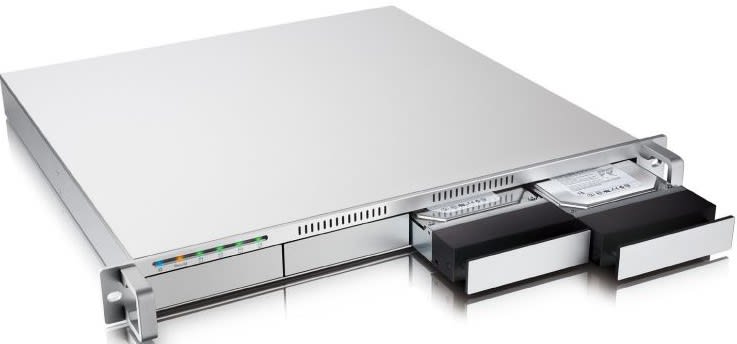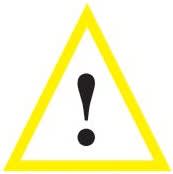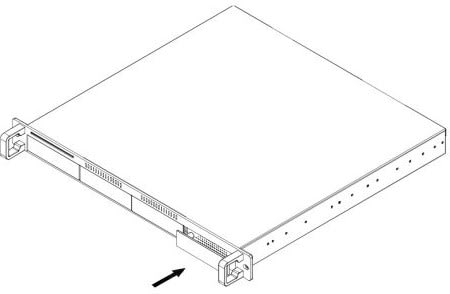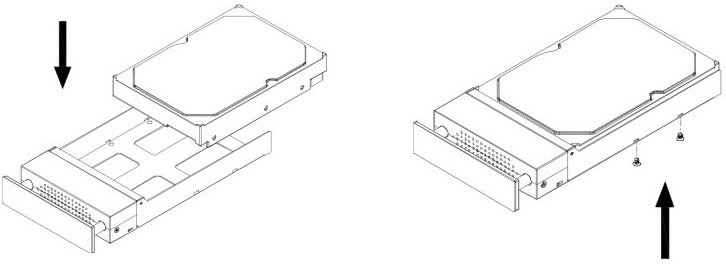Mercury Rack Pro QUAD
User Guide & Owners Manual

Introduction
1.1 System Requirements
1.1.1 Mac Requirements
- Minimum PowerPC G4 Processor, 128MB RAM
- eSATA interface, Mac OS X 10.3 or later (OR)
- FireWire interface, Mac OS X 10.2 or later (OR)
- USB 2.0 interface, Mac OS X 10.2 or later
1.1.2 PC Requirements
- Minimum 500MHz Intel Pentium 3 CPU, 128MB RAM
- eSATA interface, Windows XP / Vista (OR)
- FireWire interface, Windows 2000 / XP / Vista (OR)
- USB 2.0 interface, Windows 2000 / XP / Vista
1.1.3 Supported Hard Drives
- Up to 4 3.5” SATA-I or SATA-II hard drives (1.5Gb/s or 3.0Gb/s)
- 40GB - 2.0TB per HDD
- Hard Drives of identical capacity / model are recommended
1.2 Contents
| Item | Quantity |
|---|---|
| OWC Mercury Rack Pro | 1 |
| SATA Hard Drive in tray (installed) | 4 |
| eSATA cable | 1 |
| 1394A FireWire 400 cable | 1 |
| 1394B (FireWire 800) cable | 1 |
| USB 2.0 (A-B) cable | 1 |
| Power cable | 1 |
| Software Bundle CD | 1 |
| User Guide & Owner’s Manual | 1 |
1.3 About This Manual
Firmware, images, and descriptions may vary slightly between this manual and the shipping unit. Functions and features may change depending on the firmware version. Please visit the product webpage for the most recent specifications.
1.4 Port View

Cable Connections:
Attachment of the cables is simple on any platform.
- Plug the power input cord into the wall and to the OWC Mercury Rack Pro.
- Connect the eSATA, FireWire 800, FireWire 400, or USB 2.0 cable - appropriate for the interface your computer supports, into the drive and computer. (eSATA recommended for maximum performance)
Your OWC Mercury Rack Pro is preconfigured as a RAID 5, formatted Mac OS Extended for the Macintosh and is ready to use. If you want to change this configuration, please follow the instructions in the manual to do so.
1.5 RAID Configuration

1.5.1 LED Indicators
Power:
- Off = Power off
- Blue = Power on
Rebuild:
- Blinking orange = Rebuilding RAID array
- Steady orange = One or more faulty drive(s)
HDD:
- Blinking green = Data access (read/write)
- Blinking red = System starting up
- Steady red = Error or HDD is not installed

When only 2 or 3 hard drives are installed, the red LED indication for missing hard drives can be safely ignored.

1.5.2 RAID Selector Switch
| SWITCH POSITION | FUNCTION |
|---|---|
| 0 | Not in use (software setting) |
| 1 (SPAN) | Spanning with 2 hard drives |
| 2 (SPAN) | Spanning with 4 hard drives |
| 3 (RAID 0) | RAID 0 Striping with 2 hard drives |
| 4 (RAID 0) | RAID 0 Striping with 4 hard drives |
| 5 (RAID 1) | RAID 1 Mirroring with 2 hard drives |
| 6 (RAID 10) | Mirroring & Striping with 2 hard drives |
| 7 (RAID 5) | RAID 5 with 3 hard drives |
| 8 (RAID 5) | RAID 5 with 4 hard drives |
| 9 (RAID 5) | RAID 5 with 3 hard drives + 1 spare |

Changing the RAID mode will require you to reformat the hard drives. Be sure to back up your data first!
NOTE:
Hard drives with identical capacities are recommended.
1.5.3 Smart Fan
The smart fan automatically regulates the fan speed according to the internal temperature. It will start using low speed, increasing speed starting from 113 degrees Fahrenheit for every 5 degrees Fahrenheit until 140 degrees Fahrenheit is reached and then use full speed above 140 degrees Fahrenheit.
1.5.4 Buzzer
When the jumper on pin J10 is removed, the buzzer will sound an alarm when the fan fails.
1.6 RAID Modes
1.6.1 Disk Spanning
The drives show up as one large single volume but the total size will depend on the drive with the smallest capacity. Spanning is an array (not RAID) that is written sequentially to, across the hard drives. By itself, it does not provide any performance or redundancy benefits.

1.6.2 Disk Striping (RAID 0)
The drives show up as one large single volume but the total size will depend on the drive with the smallest capacity. Used where speed is the primary objective but RAID Level 0 (also called striping) is not redundant. This form of array splits each piece of data across the drives in segments. Since data is written without parity data-checking, it allows for the fastest data transfer rates, but if one drive fails, the whole array can become corrupted.

1.6.3 Disk Mirroring (RAID 1)
The drives show up as one volume but only 50% of the total capacity can be used, depending on the drive with the smallest capacity. RAID 1 creates an exact copy (or mirror) of a set of data on the second drive. This is useful when reliability and backup are more important than capacity. When one drive fails, it can be replaced and the data rebuilt.

1.6.4 Disk Mirroring with Striping (RAID 10) (also known as RAID 1+0)
The drives show up as one volume but only 50% of the total capacity can be used, depending on the drive with the smallest capacity. RAID 10 creates an exact copy (or mirror) of a set of data but also uses a RAID 0 Stripe for speed. When one hard drive fails, it can be replaced and the data rebuilt automatically.

1.6.5 Disk Striping with parity (RAID 5)
The drives show up as one volume but the total capacity, depending on the drive with the smallest capacity, is the combined size minus the size of one drive. RAID 5 uses block level striping with parity data distributed across all member disks and therefore provides the perfect balance between high performance and data integrity. When one hard drive fails, it can be replaced and the data rebuilt automatically.

Spare Drive
When 3 hard drives plus 1 spare drive are used, the total capacity will be only as large as two drives. When one drive fails, the data will be rebuilt immediately by using the spare drive, rather than waiting for the faulty drive to be replaced.
NOTE:
Hard drives of identical capacities are recommended, and even better would be matching model numbers of drive mechanism. If the capacity is different, the total amount of the space that can be used will depend on the drive with the smallest capacity. The difference in performance is only visible with fast interfaces, such as eSATA.
1.6.6 Changing the RAID mode
Changing the RAID setup will require you to reformat the hard drives. Make sure that you have backed up your data before proceeding!
- Turn off the power and then change the RAID selector switch to the new desired position.
- Turn on the power, erase the old partition, create a new one and then reformat the drives.
2 System Setup
2.1 Hard Drive Assembly
The hard drives can be installed at any position, there is no specific order required.

- Push the front panel of the drive tray and release it. Grab the tray and pull it out of the rack-mount chassis
- Install the hard drive as illustrated at the bottom of this page, with the SATA connector facing away from the front of the tray. Mount the drive with the 4 screws, 2 on each side.
- Slide the tray back into the case, pushing it tightly into place and fasten the screw.
- Repeat the previous 2 steps for each hard drive tray you are installing.
- Set the RAID selector switch. Turn on the power, connect the drive to your computer using the interface of your choice. Create a new partition and format the hard drives.
NOTE: Be careful to not damage any components, and do not force the drives into place. If they don’t slide in properly, make sure the drives are properly installed into the cassettes before proceeding.
IMPORTANT:
It is not possible to add more drives to an existing RAID array without reformatting. To add additional drives at a later point, turn off the power, install the drive(s), change the RAID selector switch to the new position, turn the power back on and then erase the old partition and format the drives again.

2.2 Replacing Hard Drives
When one of the hard drives fails, the Rebuild LED will light up orange and the corresponding HDD LED will light up red. If only one drive is defective and the RAID mode is set to RAID 1, RAID 5, or RAID 10, the data can still be accessed but we strongly suggest that you replace the faulty drive mechanism immediately to assure continued backup and data safety.
If more than one drive fails at the same time, or if the RAID mode is set to RAID 0 or SPAN, the data will be lost and the system cannot be accessed again until the drive(s) are replaced and the array rebuilt new.
- Check the HDD LED and replace the faulty drive. The red LED indicates the defective HDD. The power does not have to be turned off when replacing the drive(s).
- A few seconds after installing the new drive(s), the corresponding LED will turn green.
- For RAID 1, RAID 5, and RAID 10, the RAID array will be rebuilt automatically. During the rebuild process, the Rebuild LED will blink orange. Rebuilding the RAID array will take several hours, depending on drive capacity.
- For RAID 0 and SPAN, erase the old partition, create a new one and then reformat the drives again.
NOTE: We recommend not turning the power off during the rebuild process but if it is interrupted, it will continue rebuilding the data as soon as the power is restored.
2.3 Connection to Computer
-See section 1.4 for a visual representation of the cable connections-
A few precautions and notes when using your external storage device:
- Do not expose the product to water or humid conditions.
- Do not cover the enclosure’s ventilation holes.
- Only one interface at a time can be used.
- When more than one interface cable is connected, the eSATA interface has priority. To use a different interface, disconnect the other cables first before connecting a new one.
- Before connecting the device to your computer, install the hard drives, and set your preferred RAID mode.
- For the safe removal of your drive and to assure that no data is lost, always eject or dismount the drive from your operating system before powering off.
- In order for the computer to access volumes larger than 2TB, both the hardware and Operating System need to support large volumes (e.g.: Windows Vista 32bit/64bit or Mac OS X 10.4 and above).
3 Appendix
3.1 FAQ
Q: How do I format my storage solution?
A: OWC has detailed instructions for most popular operating systems online, located here: http://eshop.macsales.com/tech_center/fwhdd.cfm
Q:What file system should I choose to format my drive?
A: This will depend on how you want to use the drive, but in general, we recommend:
- Mac OS X - HFS + (Mac OS Extended)
- Windows 2000/XP/Vista
- For cross-platform compatibility, FAT32 is compatible, but single file sizes are limited to 4GB. Other options using 3rd party software exist but are not covered here.
Q: Why does my solution (over2TB) not show up when using Windows 2000 / XP?
A: For volumes larger than 2TB, your Operating System also needs to support it in order to access the drive (e.g. 64-bit System).
Q:How many drives can fail before I lose my data?
A: This depends on the RAID mode. For RAID 0 and SPAN, any drive failure will result in the data being lost. For RAID 1, RAID 5, and RAID 10, more than one drive failure at the same time will mean that data cannot be recovered.
Q:Will the hard drives spin down when my computer goes to sleep or stand-by mode?
A: No, to provide immediate access to your data, the drives will not spin down or go into sleep mode as long as the power switch is turned on.
Q: Why does the LED indicator for some of the drives light up red?
A: If one of the HDD LEDs lights up red and at the same time the Rebuild LED lights up orange, the drive is defective. If less than 4 drives are installed and the Rebuild LED light does not light up at the same time, it is indicating there is no drive installed in that bay.
3.2 About Data Backup
To ensure that your files are protected and to prevent the loss of your data, we strongly suggest that you keep two copies of your data. One copy on your OWC Mercury Rack Pro Quad and a second copy on either your internal hard drive or another storage media, such as an optical backup, or a second external hard drive. Any data loss or corruption while using the OWC Mercury Rack Pro Quad is the sole responsibility of the user, and under no circumstances will Other World Computing be held liable for compensation or the recovery of any lost data.
4 Customer Service
4.1 Before Contacting Customer Service
- Read the manuals and review Chapter 3: Appendix
- Try and confirm the problem is with the hard drive. If you have a second computer, move the drive to that system and verify that the solution does not function with that machine.
Visit our tech center for more support suggestions, including FAQs. http://eshop.macsales.com/tech_center/index.cfm
If you still need support:
- Have the serial number of the hard drive handy
- Your invoice number (if possible)
- What operating system you are using
- Which kind of computer you are using
4.2 Support Hours Of Operation
Tech Support Hours (Central Standard Time)
8AM - 8PM Monday - Friday
9AM - 4PM Saturday
Phone (800) 275-4576
Live Chat is available during normal business hours as well. Visit http://eshop.macsales.com for more information.
Or, you can email: Submit your email at: http://eshop.macsales.com/Service/Tech.cfm
Copyrights
Copyright © 2009 Other World Computing, Inc. All rights reserved. No part of this publication may be reproduced, stored in a retrieval system, or transmitted in any form or by any means, electronic, mechanical, photocopying, recording or otherwise, without the prior written consent of Other World Computing.
Changes
The material in this document is for information only and subject to change without notice. While reasonable efforts have been made in the preparation of this document to assure its accuracy, Other World Computing assumes no liability resulting from errors or omissions in this document, or from the use of the information contained herein. Other World Computing reserves the right to make changes or revisions in the product design or the product manual without reservation and without obligation to notify any person of such revisions and changes.
FCC Statement:
Warning! Modifications not authorized by the manufacturer may void the user’s authority to operate this device.
NOTE: This equipment has been tested and found to comply with the limits for a Class A digital device, pursuant to Part 15 of the FCC Rules. These limits are designed to provide reasonable protection against harmful interference when the equipment is operated in a commercial environment. This equipment generates, uses, and can radiate radio frequency energy and, if not installed and used in accordance with the instruction manual, may cause harmful interference to radio communications. Operation of this equipment in a residential area is likely to cause harmful interference in which case the user will be required to correct the interference at his own expense.
NOTE: This equipment has been tested and found to comply with the limits for a Class B digital device, pursuant to Part 15 of the FCC Rules. These limits are designed to provide reasonable protection against harmful interference in a residential installation. This equipment generates, uses and can radiate radio frequency energy and, if not installed and used in accordance with the instructions, may cause harmful interference to radio communications. However, there is no guarantee that interference will not occur in a particular installation. If this equipment does cause harmful interference to radio or television reception, which can be determined by turning the equipment off and on, the user is encouraged to try and correct the interference by one or more of the following measures:
- Reorient or relocate the receiving antenna.
- Increase the separation between the equipment and receiver.
- Connect the equipment into an outlet on a circuit different from that to which the receiver is connected.
Health And Safety Precautions
- Use proper anti-static precautions while performing the installation of your hard drives into this drive enclosure. Failure to do so can cause damage to your drive mechanisms, and / or the hard drive enclosure.
- Read this User’s Guide carefully, and follow the correct procedure when setting up the device.
- Do not open your hard drive or attempt to disassemble or modify it. Never insert any metallic object into the drive to avoid any risk of electrical shock, fire, short-circuiting or dangerous emissions. Your hard drive contains no user-serviceable parts. If it appears to be malfunctioning, have it inspected by a qualified Other World Computing Technical Support representative.
- Never expose your device to rain, or use it near water, or in damp or wet conditions. Never place objects containing liquids on the drive, as they may spill into its openings. Doing so increases the risk of electrical shock, short-circuiting, fire or personal injury.
General Use Precautions:
- Do not expose the hard drive to temperatures outside the range of 5° C to 40° C (41° F to 104° F). Doing so may damage the drive or disfigure its casing. Avoid placing your drive near a source of heat or exposing it to sunlight (even through a window). Inversely, placing your drive in an environment that is too cold or humid may damage the unit.
- Always unplug the hard drive from the electrical outlet if there is a risk of lightning or if it will be unused for an extended period of time. Otherwise, there is an increased risk of electrical shock, short-circuiting or fire.
- Use only the power supply shipped with the device.
- Do not use the hard drive near other electrical appliances such as televisions, radios or speakers. Doing so may cause interference which will adversely affect the operation of the other products.
- Do not place the drive near sources of magnetic interference, such as computer displays, televisions or speakers. Magnetic interference can affect the operation and stability of your hard drive.
- Do not place heavy objects on top of the drive or use excessive force on it.
- Never use excessive force on your drive. If you detect a problem, consult the Troubleshooting section in this manual.
- Protect your hard drive from excessive exposure to dust during use or storage. Dust can build up inside the device, increasing the risk of damage or malfunction.
- Other World Computing recommends the use of normal glass cleaning products to keep the high lustre finish at it’s finest with this product. Be sure to not get any moisture inside the holes and if you do, allow time to air dry before use.
- Do not block the ventilation outlets on the rear of the drive. These help to keep your drive cool during operation. Blocking the ventilation outlets may cause damage to your drive and cause an increased risk of short-circuiting or fire.
Free Support Chat
Our free award-winning support team is ready to answer all of your questions. Technical support is available Monday - Friday: 9AM - 6PM. Customer Support & Sales is available Monday - Friday: 9AM - 6PM. Support is unavailable on U.S. Federal holidays. Talk to a human today.

 1-800-275-4576
1-800-275-4576